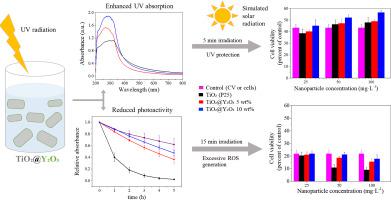当前位置:
X-MOL 学术
›
J. Photochem. Photobiol. B Biol.
›
论文详情
Our official English website, www.x-mol.net, welcomes your
feedback! (Note: you will need to create a separate account there.)
Y2O3 decorated TiO2 nanoparticles: Enhanced UV attenuation and suppressed photocatalytic activity with promise for cosmetic and sunscreen applications.
Journal of Photochemistry and Photobiology B: Biology ( IF 3.9 ) Pub Date : 2020-04-17 , DOI: 10.1016/j.jphotobiol.2020.111883 Marcela Chaki Borrás 1 , Ronald Sluyter 2 , Philip J Barker 3 , Konstantin Konstantinov 4 , Shahnaz Bakand 5
Journal of Photochemistry and Photobiology B: Biology ( IF 3.9 ) Pub Date : 2020-04-17 , DOI: 10.1016/j.jphotobiol.2020.111883 Marcela Chaki Borrás 1 , Ronald Sluyter 2 , Philip J Barker 3 , Konstantin Konstantinov 4 , Shahnaz Bakand 5
Affiliation

|
Nanoparticulate titanium dioxide (TiO2) is widely used in cosmetic products and sunscreens. However, primarily due to their photocatalytic activity, some TiO2 products have been shown to be cytotoxic. Thus, the aim of this study was to reduce the photoactivity and consequent cytotoxicity of TiO2nanoparticles. As such, in this work, yttrium oxide (Y2O3) was deposited onto TiO2, at 5% and 10% Y/Ti weight ratio, via a hydrothermal method. The nanocomposites produced, TiO2@Y2O3 5 and 10 wt%, were characterised to assess their physical, photochemical and toxicological properties. These materials exhibit a uniform yttria coating, enhanced UV attenuation in the 280-350 nm range and significantly reduced photoactivity compared with a pristine commercial TiO2 sample (Degussa Aeroxide® P25). Furthermore, the comparative cytotoxicity and photo-cytotoxicity of these materials to a human keratinocyte cell line (HaCaT), was assessed using a colorimetric tetrazolium salt (MTS) assay. Following 24-hour incubation with cells, both Y2O3 loadings exhibited improved biocompatibility with HaCaT cells, compared to the pristine TiO2 sample, under all subsequent test conditions. In conclusion, the results highlight the potential of these materials for use in products, applied topically, with sun protection in mind.
中文翻译:

Y2O3装饰的TiO2纳米颗粒:增强的紫外线衰减和抑制的光催化活性,有望用于化妆品和防晒霜。
纳米二氧化钛(TiO2)广泛用于化妆品和防晒霜。但是,主要由于它们的光催化活性,一些TiO2产品已被证明具有细胞毒性。因此,本研究的目的是减少TiO2纳米颗粒的光活性和随之产生的细胞毒性。这样,在这项工作中,通过水热法以5%和10%的Y / Ti重量比将氧化钇(Y2O3)沉积在TiO2上。制备的纳米复合材料TiO2 @ Y2O3 5和10 wt%被表征为评估其物理,光化学和毒理学性质。与原始的商用TiO2样品(DegussaAeroxide®P25)相比,这些材料具有均匀的氧化钇涂层,在280-350 nm范围内增强的UV衰减以及显着降低的光活性。此外,使用比色四唑鎓盐(MTS)分析评估了这些材料对人角质形成细胞系(HaCaT)的比较细胞毒性和光细胞毒性。与细胞孵育24小时后,在所有后续测试条件下,与原始TiO2样品相比,两种Y2O3负载量均与HaCaT细胞表现出改善的生物相容性。总之,结果突出了这些材料在产品中使用的潜力,特别是在防晒方面,已局部使用。
更新日期:2020-04-17
中文翻译:

Y2O3装饰的TiO2纳米颗粒:增强的紫外线衰减和抑制的光催化活性,有望用于化妆品和防晒霜。
纳米二氧化钛(TiO2)广泛用于化妆品和防晒霜。但是,主要由于它们的光催化活性,一些TiO2产品已被证明具有细胞毒性。因此,本研究的目的是减少TiO2纳米颗粒的光活性和随之产生的细胞毒性。这样,在这项工作中,通过水热法以5%和10%的Y / Ti重量比将氧化钇(Y2O3)沉积在TiO2上。制备的纳米复合材料TiO2 @ Y2O3 5和10 wt%被表征为评估其物理,光化学和毒理学性质。与原始的商用TiO2样品(DegussaAeroxide®P25)相比,这些材料具有均匀的氧化钇涂层,在280-350 nm范围内增强的UV衰减以及显着降低的光活性。此外,使用比色四唑鎓盐(MTS)分析评估了这些材料对人角质形成细胞系(HaCaT)的比较细胞毒性和光细胞毒性。与细胞孵育24小时后,在所有后续测试条件下,与原始TiO2样品相比,两种Y2O3负载量均与HaCaT细胞表现出改善的生物相容性。总之,结果突出了这些材料在产品中使用的潜力,特别是在防晒方面,已局部使用。











































 京公网安备 11010802027423号
京公网安备 11010802027423号